The millennials who are taking to the water to become fly-fishers
It’s no longer a sport for old men, but for the trendy twenty-something. Alexandra Marvar meets the new generation of fishers
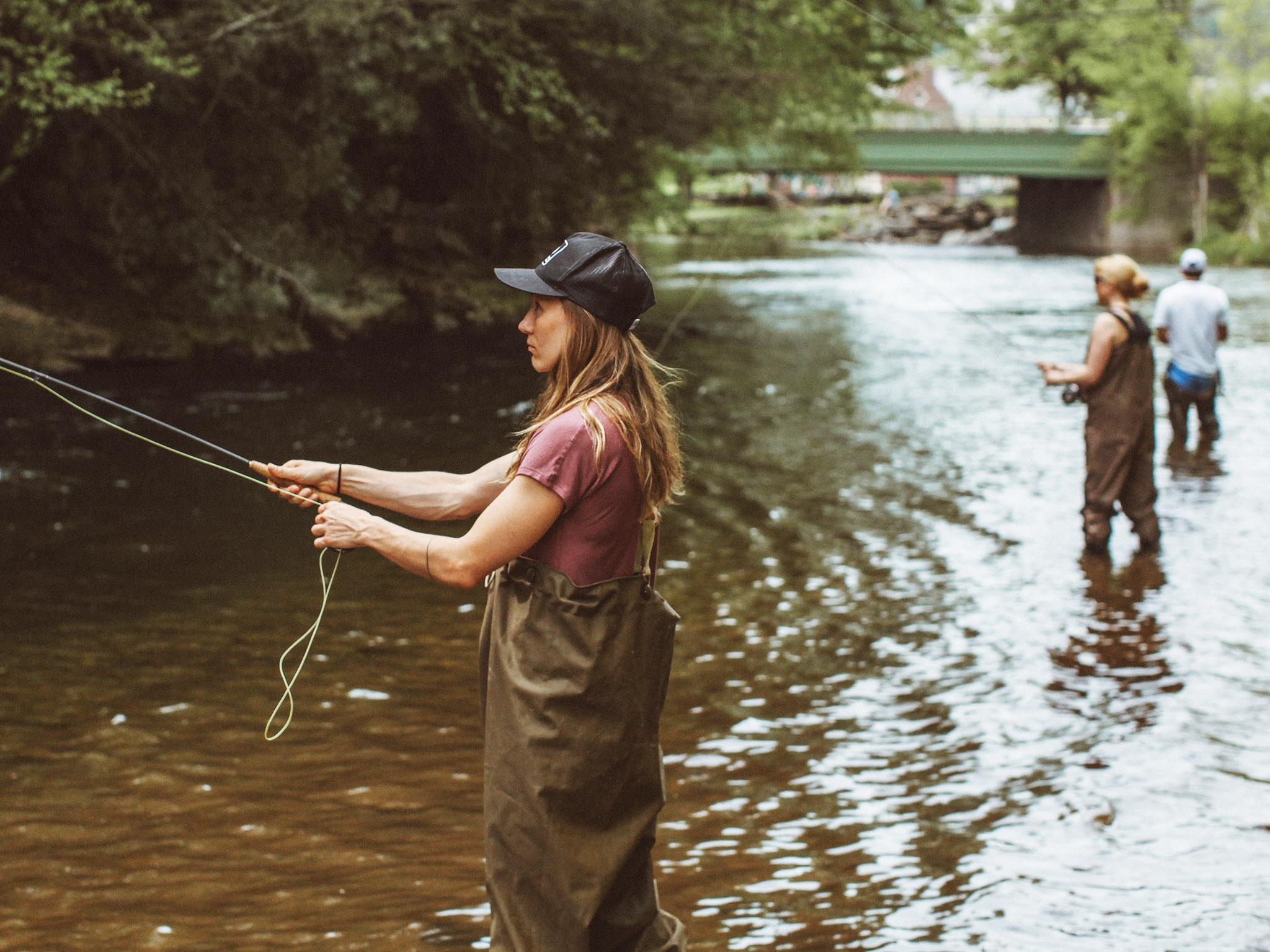
Your support helps us to tell the story
From reproductive rights to climate change to Big Tech, The Independent is on the ground when the story is developing. Whether it's investigating the financials of Elon Musk's pro-Trump PAC or producing our latest documentary, 'The A Word', which shines a light on the American women fighting for reproductive rights, we know how important it is to parse out the facts from the messaging.
At such a critical moment in US history, we need reporters on the ground. Your donation allows us to keep sending journalists to speak to both sides of the story.
The Independent is trusted by Americans across the entire political spectrum. And unlike many other quality news outlets, we choose not to lock Americans out of our reporting and analysis with paywalls. We believe quality journalism should be available to everyone, paid for by those who can afford it.
Your support makes all the difference.Step aside, goat yoga. The chic way to unwind now is fly-fishing. That’s right. For some of the same reasons millennials recently flocked to bird-watching, this sport – long dominated by old white men – is gaining popularity with a younger set. For those who can afford the leisure time and some rudimentary equipment, it offers a reason to be outdoors, a closer connection to nature, an avenue for environmentalism, built-in community, opportunity for creative expression, and a lifetime’s worth of niche expertise. Fly anglers who are not vegetarian nor vegan, nor otherwise bound by the code of “catch and release”, see it as an extension of the farm-to-table movement. Plus, it’s very Instagrammable, even as it encourages people to put down their phones.
And where millennials go, hospitality brands follow. Guided fly-fishing excursions are now offered at many trendy boutique hotels, including The Little Nell in Aspen, Colorado; Tourists, the eco-friendly lodge opened by indie influencers including the bassist from Wilco, in North Adams, Massachusetts; and Sage Lodge, a new nature resort just north of Yellowstone National Park in Pray, Montana, which has a stand of fly tackles and nets in its lobby, and daily Fly Fishing 101 courses at its backyard casting pond overlooking the Absaroka Mountains.
At the DeBruce, a boutique hotel and culinary destination in Livingston Manor, New York, the wall art, bookshelves and nine-course tasting menu are fly-fishing-themed. The banner amenity of the hotel, where rooms start at $449 (£348) a night (including breakfast and the tasting menu), is half a mile of private river; waders, rods and reels are all available for rental for $75 per day in the Tackle Room near the pool. And in the Great Room, where elegant young couples on honeymoons, babymoons and minimoons pass their happy hours, a full fly-tying station is set up in the corner.
Todd Spire, 45, a digital marketer turned full-time fly guide, has built his Catskills business on this new wave of interest. Over the past four years, his guiding outfit, Esopus Creel, grew steadily by word-of-mouth and Instagram, and this spring, he opened a brick-and-mortar fly shop in Phoenicia, New York.
“You have millennials who are drawn to experiences, looking for authentic ways to experience this place, and you have this activity which is such a big part of both this area’s history and its conservation,” Spire says. And, he notes, the area is of historic importance to the sport. “Almost every aspect of fly fishing was refined, changed, evolved in the Catskills.”
And indeed, when clients fish in the Esopus Creek with Spire, they’re waist-deep in the same waters where Babe Ruth fished during the late 1930s. Decades before that, pioneering sportsmen like Theodore Gordon and Edward Ringwood Hewitt fished on the Neversink River. Nearby, on the Beaverkill River, the inventor of the fishing vest, Lee Wulff, perfected the use of his namesake flies, while his wife at the time, Joan Wulff, a competitive angler, brought novel poise and femininity to the craft of casting them. She once cast a cigarette out of Johnny Carson’s mouth on the daytime game show Who Do You Trust? Joan, now in her 90s, still teaches at the 40-year-old school they founded, run out of a cabin near Livingston Manor.
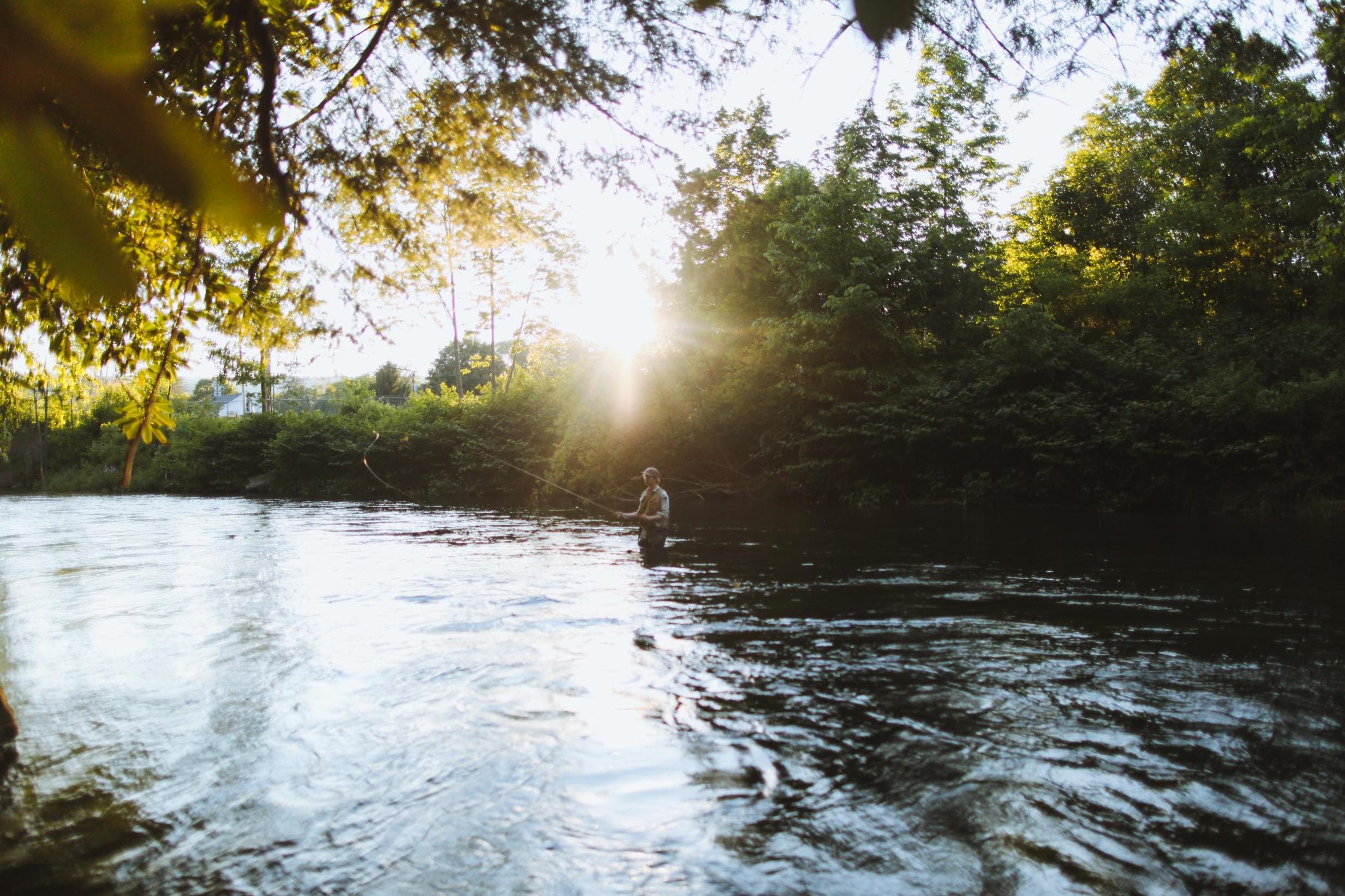
“I’ve become completely addicted to fly fishing,” says Mike Kauffman, 31, a tech entrepreneur and Manhattan resident who recently bought a home in the Catskills with his girlfriend, Annah Lansdown. “I find it totally meditative – the thing I never knew I needed.”
When he started out this spring, Kauffman knew virtually nothing about the sport: “I was at Phoenicia Diner and I saw ‘Esopus Creel’ on their menu,” he says, referring to an ad. “I thought, ‘Oh man, they spelled ‘creek’ wrong.’ ”
But from his first guided outing with Spire, Kauffman and his girlfriend were hooked. “We’re scrolling all day thinking we’re connecting with the world, but our minds aren’t satisfied,” he says. “Being out in that river is a deeper connection to nature I never really had – and I think a lot of people don’t have. It’s something our monkey brain needs
Lansdown, 41, a creative director at a digital agency, adds, “The water’s rushing around you, and you can’t hear anything. You can’t even hear people yelling at you. You don’t think about work, or emails, or the city.”
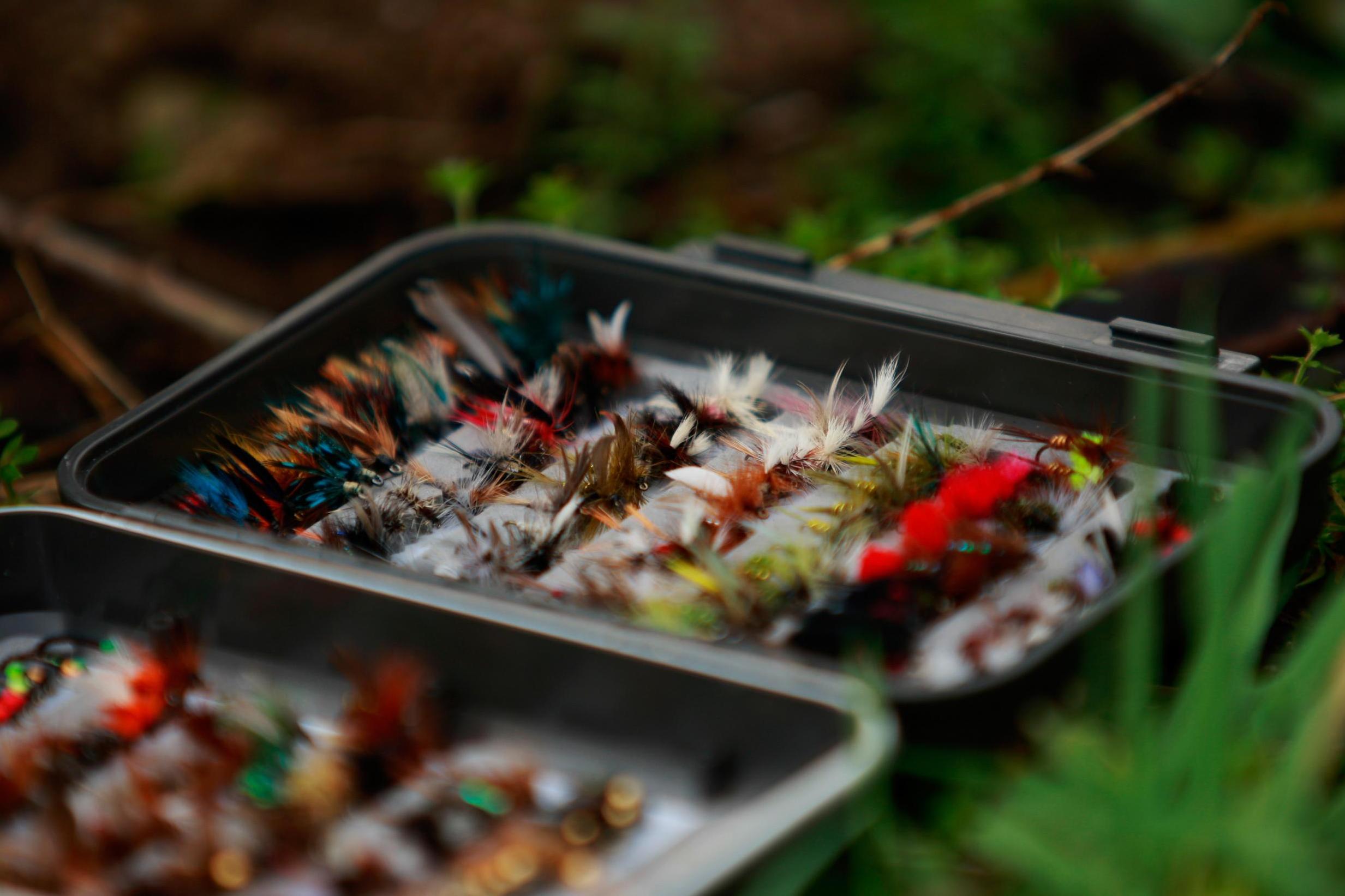
Now, the couple owns all the gear. And there’s plenty of gear and apparel to own. Newcomers may require waders, vests, tackle boxes, rods, reels, creels, flies and perhaps even fly-tying equipment. Graphite rods can cost as little as $30 but classic bamboo rods – preferred by Brad Pitt in the 1992 movie A River Runs Through It – can cost thousands. (For those seeking the highest-end option, Hermès recently debuted a wooden fly rod, priced at $13,790, and a wicker and calfskin creel for $17,420.)
“I can’t put my finger on what it was, but about five years back, something changed,” says Joe Fox, 33, a manager at Dette Flies fly shop in Livingston Manor. “Especially in the past three years, we started seeing more new faces.”
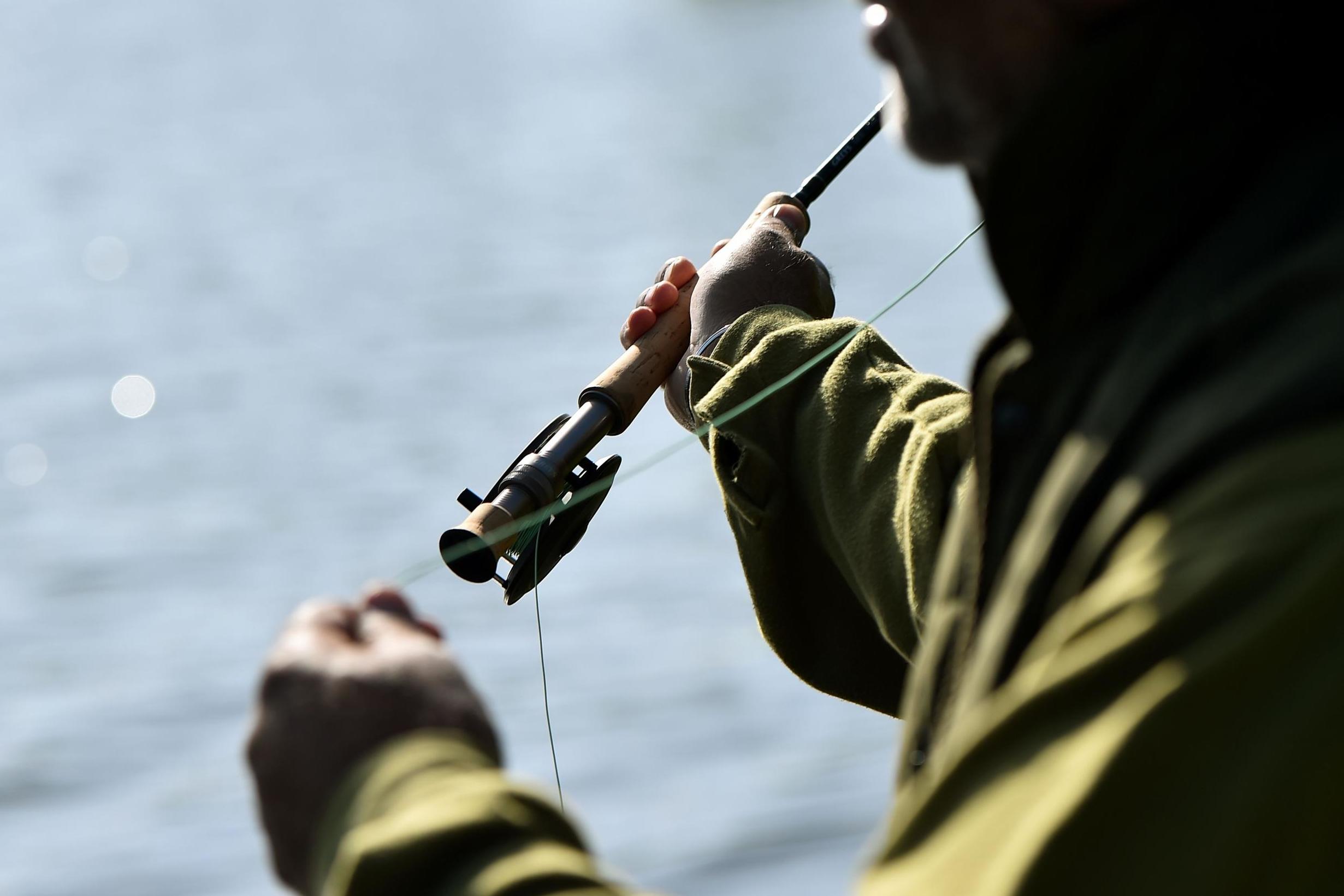
According to the 2019 Outdoor Industry Association’s Special Report on Fishing, fly-fishing is the fastest-growing category of the sport. Gender and racial diversity continues to tick upward. Age diversity encompasses both categories. Last year, one in four anglers surveyed were in the 18-to-34 age range. Fox recently took over the family fishing supply business from his grandmother, who’d herself taken over from his great-grandparents, Winnie and Walt Dette. He launched a web store and, this past year, he and his partner, Kelly Buchta, also a fly angler, moved the business, which had been in the Dette family home in Roscoe, New York since 1928, to a spacious new store on Livingston Manor’s main street. Longtime customers have stayed loyal. New customers continue to arrive.
In 2011, the store experienced a surge of attention shortly after celebrities like Selena Gomez and Steven Tyler, for inexplicable reasons, got into weaving grizzly saddle hackles – long, thin, speckled rooster feathers – through their hair. In short time, the style went viral. Shops like Dette began to sell out of their fly-tying supplies, and in the lead-up to Bonnaroo Arts & Music Festival that spring, virtually nobody could keep feathers in stock. Prices spiked. Some anglers were furious; others took to eBay with their spare hackles, selling them for 10 times the buying price.
This time, the newcomers are buying Dette’s wares for their intended purpose.
Defying the ‘Tweed Brigade’
The name of the Livingston Manor Fly Fishing Club may recall the elite private fishing clubs of the old-school Catskills angling community, but this creekside glamping village – where annual memberships cost hundreds, not thousands, of dollars, and the benefits are tailored to weekenders – is the millennial set’s take.
Tom Roberts, 33, is a founder. With a woollen flat-brimmed cap over shaggy blonde hair, a British accent from his hometown of London and a 1972 Triumph Spitfire in “British racing green”, he cuts a smart picture of Instagram escapism. (His dog, a mutt named Biscuit with the muddled coat of a German pointer, completes the picture. Roberts calls her the club’s director of marketing.)
The property includes a clubhouse, greenhouse and trail through the woods to the edge of the Willowemoc Creek, where a hand-built banquet table runs parallel to the waterfront. Benches are strewn with fur pelts. Lights are strung in the trees. Guests and members stay in bedrooms in the main clubhouse, or in canvas tents equipped with a rustic take on luxury amenities, several of them Swedish: Sandqvist bags, Stutterheim raincoats, and sheets by Lexington Company, a bedding brand in Stockholm.
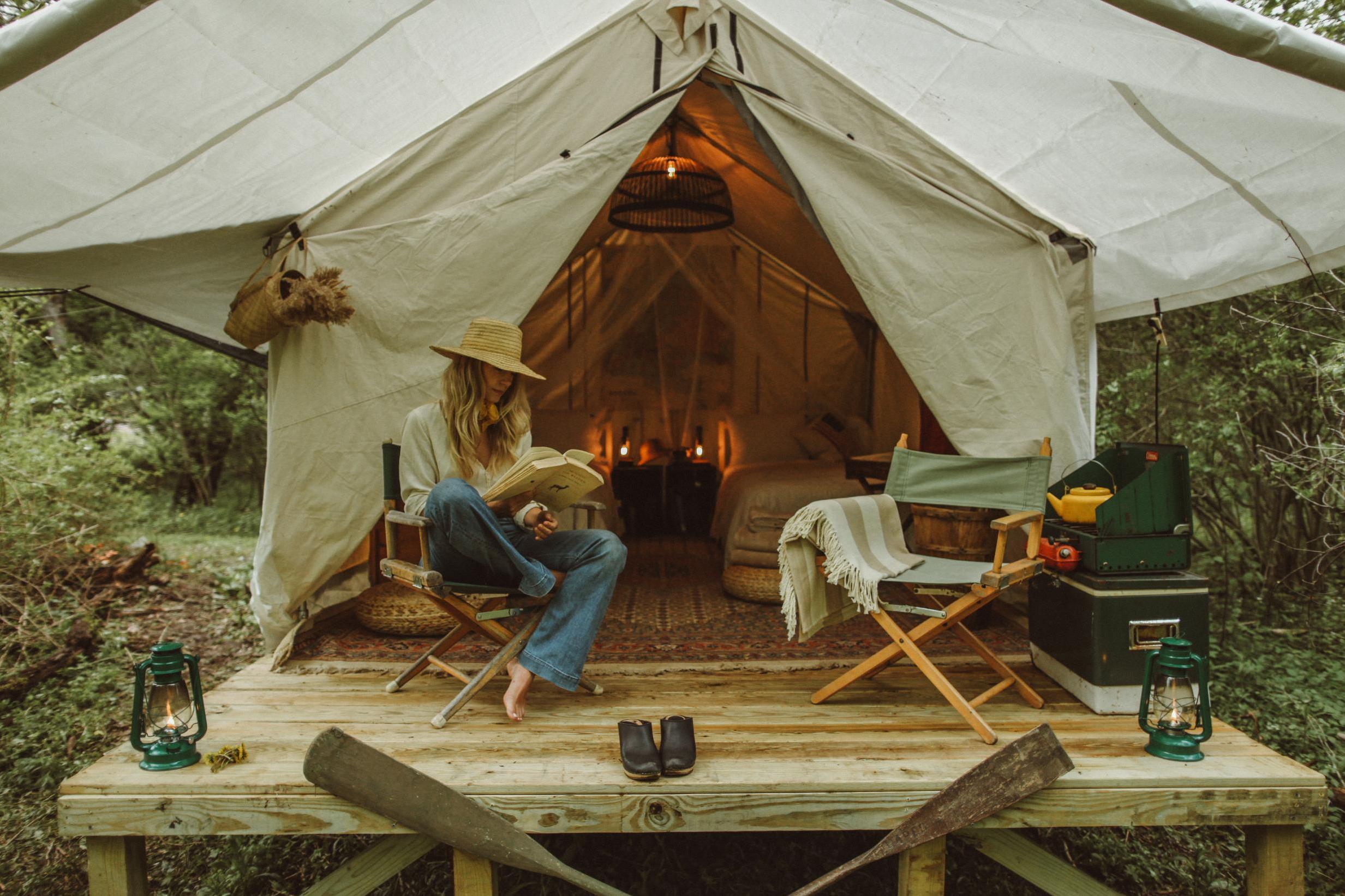
The village’s bustling Main Street is minutes, if not steps away, but it’s hard to tell from here. “My grandfather was a fly-fisherman. My dad and my brother are fly-fishermen,” Roberts says. “But I never touched a rod in England. My perception of the sport was that it was stuffy and elitist. Most of the rivers are private. It’s the kind of tweed brigade that I’ve always pushed back on.”
An American friend convinced him it would be different on this side of the pond. “We came up here and got out on the river. I was useless,” Roberts says. “But it didn’t matter.” In fly-fishing, he found the same level of Zen that he loved about surfing and sailing. “There are few things we do where our technology is not somehow part of the experience. But in this case, you’re standing in a river. Both your hands are occupied. It’s very hard to make your phone part of that practice.”
Over the course of a few years, Roberts and his wife, Anna Aberg, weekended in the area. When they sought out and purchased the property with a third partner, Mikael Larsson, in 2016, Livingston Manor was beginning to attract attention from more New York City residents. “We thought it would be great to bring back some of the heritage of fly-fishing to this town. We wanted to connect the town to the name of the place, and to connect the name of the place to fly-fishing,” he says.
Fly-fishing makes natural conservationists out of people. The planet could always use more of those
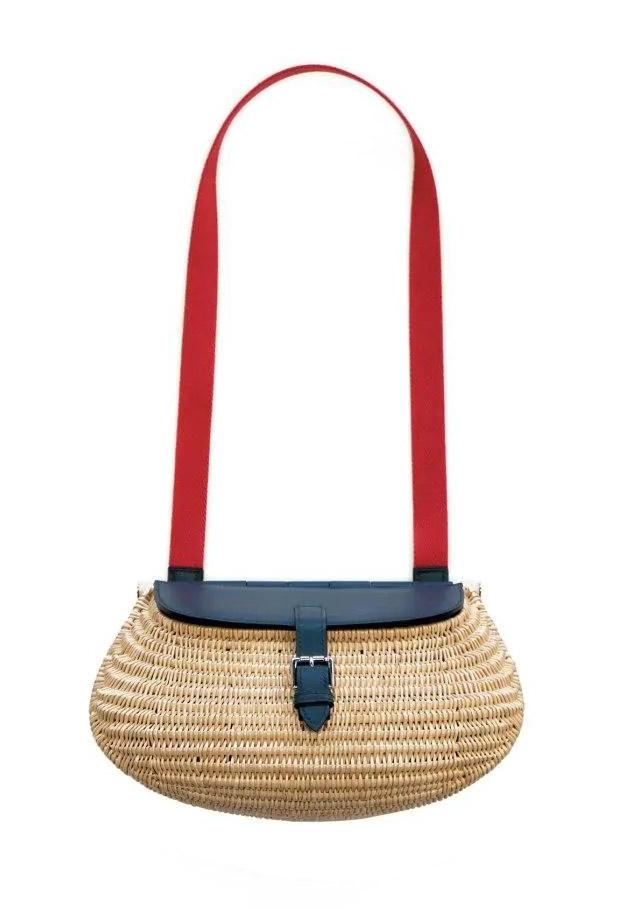
Still, guests are given the freedom to take it or leave it. Fly-fishing is not for everyone, Roberts acknowledges, and there’s always the hammock and wood-fired sauna. (The sauna sugar scrubs are home-made.)
Some of the older guard might see the Livingston Manor Fly Fishing Club as an unnecessary reinvention of the wheel, but everyone who loves fly-fishing shares the opinion that environmentalism is inextricably linked to it. Hallie Brennan, a 31-year-old freelance photographer in Santa Fe, New Mexico, who took up the hobby four years ago, says, “Fly-fishing makes natural conservationists out of people. The planet could always use more of those.” The sport’s meditative qualities help connect her to nature, she adds. “It’s a beautiful sport and I feel beautiful when I fish. And it helped me understand and respect the ecosystems of the Rocky Mountains – I once hated flies and bugs. Now I love them!”
Fins-tagram
Jessica McKay, a Gen Z angler who graduated from college in her home state of Minnesota last year, recently found a job as a fly-fishing guide in Estes Park, Colorado. She had no experience when she applied, but loved the outdoors, and the owners gave her a shot. “I’m fudging obsessed,” she posted on Instagram this past summer, with a giant grin and a hefty brown trout. (Nearly 2,000 of her approximately 3,500 followers “liked” that one.)
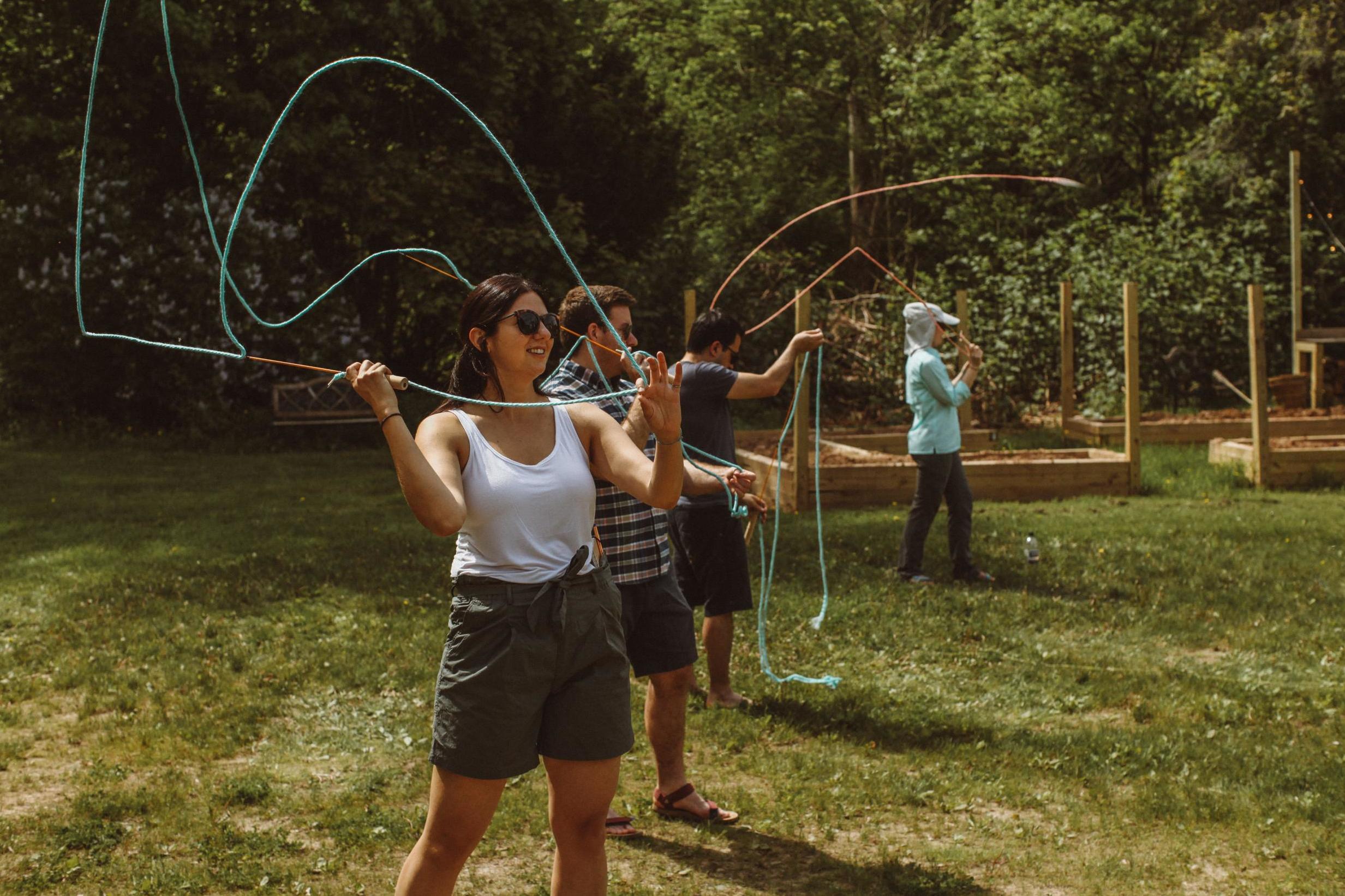
“The fishing community on Instagram is amazing,” McKay, 22, says over the phone. “I’ll have people reach out to me and ask me how to get into fly-fishing, what are good flies to use, places to go – and I’ve used Instagram so many times to have my own questions answered.”
Derek Eberly, a guide, blogger and elder millennial (born in 1983) in Lancaster, Pennsylvania, says social media has helped increase the sport’s popularity. It also has become more accessible, thanks to classes, including Orvis’ free Fly Fishing 101, which started in 2010, or local guides advertising their services on platforms like Airbnb Experiences.
The sport was a natural extension of the DIY culture that brought Eberly, as a high school student, to skateboarding and punk: building the tackles, tying the flies. “When I went to my first fly shop, they sized me up really quickly and realised I wasn’t going to spend $500 on a fly rod,” he says. “So they gave me no new information. But I was OK with that. I knew that’s what I was up against.”

Eberly says a resistance to that closed attitude is precisely why he blogs and guides, and he feels it’s becoming more a thing of the past. “I think these younger anglers recognise the need to make sure that these streams are listed and protected,” he says. “Anglers actually sharing knowledge and organising these communities online is helping to push that forward. What millennials have to learn is outweighed by what they can bring to the conservation side.”
Judy Van Put, a real estate agent and self-declared “fly-fishing broker” who has fished in the area since the 1980s, recently received an invitation for an upcoming Catskill Fly Fishing Centre and Museum fund-raiser, the second annual Emerging Anglers’ Dinner. “In addition to a very welcoming atmosphere, they have a live DJ after the dinner,” she says. “When I first began attending fly-fishing dinners they were more formal. I was always very nervous to meet with older guides.”
Now, there are meet-ups like Coffee & Casting, or Women, Waders and Wine. “That just isn’t something that would ever have occurred years ago,” she says. “But if it gets more people out on the river, so be it.”
© New York Times
Join our commenting forum
Join thought-provoking conversations, follow other Independent readers and see their replies
Comments